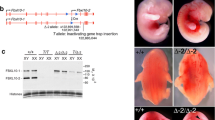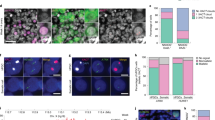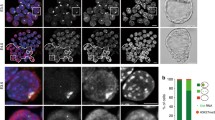Abstract
TO compensate for unequal doses of genes on the X chromosomes of males and females, one of the X chromosomes in the somatic cells of mammalian females is inactive1. This inactivation occurs early in development, although the exact time is unknown2. Before X-chromosome inactivation, and in the absence of other dosage compensating mechanisms, female embryos with two X chromosomes would be expected to have twice as much activity for an X-linked enzyme as male embryos with only one X chromosome. In a litter with approximately an equal number of male and female embryos, the distribution of enzyme activity should have two equal-sized peaks separated by a factor of two. The change from a bimodal to unimodal distribution would indicate that X-chromosome inactivation had occurred. Early in development, the X-linked enzymes α-galactosidase (α-gal)3 and hypoxanthine guanine phosphoribosyltransferase (HGPRT)4,5 are both derived from embryonic gene activity. α-gal was found to have a bimodal distribution at the morula stage3. For HGPRT, Monk and Kathuria6 found no bimodality at either the eight-cell or blastocyst stages, however further analysis revealed bimodality at certain stages7. Epstein et al.8 have found that females have twice as much HGPRT activity as males in early blastocysts. We present here evidence for the activity of both the maternal and paternal X chromosomes by the eight-cell stage, with inactivation initiated at blastulation.
Similar content being viewed by others
References
Lyon, M. F. Biol. Rev. 47, 1–35 (1972).
Gartler, S. M. & Andina, R. J. Adv. hum. Genet. 7, 99–140 (1976).
Adler, D. A., West, J. D. & Chapman, V. M. Nature 267, 838–839 (1977).
Epstein, C. J. J. biol. Chem. 245, 3289–3294 (1970).
Epstein, C. J. Science 175, 1467–1468 (1972).
Monk, M. & Kathuria, H. Nature 270, 599–601 (1977).
Monk, M. in Proc. Conf. on Genetic Mosaics and Chimeras in Mammals (ed. Russell, L.) Oak Ridge (in the press).
Epstein, C. J., Smith, S., Travis, B. & Tucker, G. Nature 274, 500–503 (1978).
Eklund, J. & Bradford, G. E. Genetics 85, 529–542 (1977).
Brinster, R. L. Biochem. Genet. 9, 187–191 (1973).
Wudl, L. & Chapman, V. M. Dev. Biol. 48, 104–109 (1976).
Krco, C. J. & Goldberg, E. H. Science 193, 1134–1135 (1976).
Muggleton-Harris, A. L. & Johnson, M. H. J. Embryol. exp. Morph. 35, 59–79 (1976).
DeMars, R. Natn. Cancer Inst. Monogr. 26, 327–351 (1967).
Takagi, N. Expl Cell Res. 86, 127–135 (1974).
Mukherjee, A. A. Proc. natn. Acad. Sci. U.S.A. 73, 1608–1611 (1976).
Nesbitt, M. N. Devl Biol. 26, 252–263 (1971).
Deol, M. S. & Whitten, N. K. Nature new Biol. 240, 277–279 (1972).
Takagi, N. & Sasaki, M. Nature 256, 640–642 (1975).
West, J. D., Frels, W. I. Chapman, V. M. & Papaioannou, V. E. Cell 12, 873–882 (1977).
Randerath, K. Thin layer Chromatography, 2nd edn., 229–234 (Academic, New York, 1966).
Hosmer, D. W. thesis, Univ. Washington (1972).
Day, N. E. Biometrika 56, 463–474 (1969).
Author information
Authors and Affiliations
Rights and permissions
About this article
Cite this article
KRATZER, P., GARTLER, S. HGPRT activity changes in preimplantation mouse embryos. Nature 274, 503–504 (1978). https://doi.org/10.1038/274503a0
Received:
Accepted:
Issue Date:
DOI: https://doi.org/10.1038/274503a0
- Springer Nature Limited
This article is cited by
-
An integrated genome-wide multi-omics analysis of gene expression dynamics in the preimplantation mouse embryo
Scientific Reports (2019)
-
X-chromosome inactivation and escape
Journal of Genetics (2015)
-
Gracefully ageing at 50, X-chromosome inactivation becomes a paradigm for RNA and chromatin control
Nature Reviews Molecular Cell Biology (2011)
-
X-chromosome inactivation: a hypothesis linking ontogeny and phylogeny
Nature Reviews Genetics (2005)
-
Genetic and parent-of-origin influences on X chromosome choice in Xce heterozygous mice
Mammalian Genome (2005)





